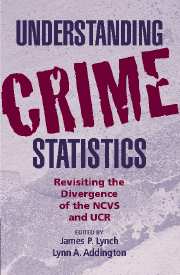Book contents
- Frontmatter
- Contents
- Acknowledgments
- Contributor Biographies
- INTRODUCTION
- OVERVIEW OF THE TWO NATIONAL MEASURES OF U.S. CRIME
- 2 Introduction to the National Crime Victimization Survey
- 3 Introduction to the Uniform Crime Reporting Program
- DEFINING DIVERGENCE AND CONVERGENCE
- SOURCES OF DIVERGENCE IN THE NCVS
- SOURCES OF DIVERGENCE IN THE UCR
- CONCLUSION
- Index
- CAMBRIDGE STUDIES IN CRIMINOLOGY
- References
3 - Introduction to the Uniform Crime Reporting Program
Published online by Cambridge University Press: 23 December 2009
- Frontmatter
- Contents
- Acknowledgments
- Contributor Biographies
- INTRODUCTION
- OVERVIEW OF THE TWO NATIONAL MEASURES OF U.S. CRIME
- 2 Introduction to the National Crime Victimization Survey
- 3 Introduction to the Uniform Crime Reporting Program
- DEFINING DIVERGENCE AND CONVERGENCE
- SOURCES OF DIVERGENCE IN THE NCVS
- SOURCES OF DIVERGENCE IN THE UCR
- CONCLUSION
- Index
- CAMBRIDGE STUDIES IN CRIMINOLOGY
- References
Summary
In 1927, the International Association of Chiefs of Police convened the Committee on Uniform Crime Records to provide much-needed information on crime trends for the nation. This small beginning was the result of years of contemplation and expressed desires by law enforcement to create a program that would afford a unified vision of the crime problem in the United States as well as provide law enforcement executives the means to compare their jurisdiction with others more easily. One of the first official mentions of the need to create a crime statistics program occurred in 1871 at a convention in St. Louis. Police executives approved a resolution “to procure and digest statistics for the use of police departments” (Official Proceedings of the National Police Convention, 1871, p. 30).
Ultimately, the creation of the Uniform Crime Reporting Program would require more than 50 years of continual effort to secure support and funding before the IACP formed the Committee on Uniform Crime Records to fulfill this need. One of the major issues that arose during the Committee's deliberations concerned the creation of a uniform data collection method that would convert the disparate state and local laws and definitions into one standardized system. In its finalized format, the IACP created a program based on seven standardized offense definitions, which became the centerpiece of the Uniform Crime Reporting (UCR) Program.
In 1930, the UCR Program's first year of data collection, 400 law enforcement agencies in 43 states reported data to the Federal Bureau of Investigation.
- Type
- Chapter
- Information
- Understanding Crime StatisticsRevisiting the Divergence of the NCVS and the UCR, pp. 55 - 90Publisher: Cambridge University PressPrint publication year: 2006
References
- 5
- Cited by

